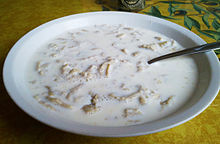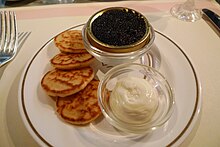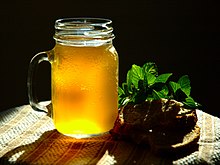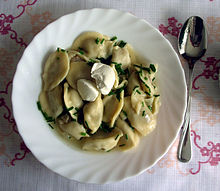Russian cuisine

The Russian cuisine ( Russian русская кухня , russkaja kuchnja ) exists in its present form for about a hundred years. It developed from a long tradition that went through several phases:
- Old Russian cuisine from the 9th to the 16th century
- the kitchen of the Moscow state in the 17th century
- the cuisine of the 18th century and the Petersburg cuisine of this period
- all-Russian cuisine in the 19th century
- Soviet cuisine since 1917.
Individual dishes and ingredients of Russian cuisine are world famous, such as caviar , pickled gherkins , vodka , Krimsekt , borsch , pelmeni , shashlik , piroshki , beef stroganoff , Chicken Kiev , sauerkraut ( Russian Квашеная капуста , Kwaschenaja kapusta ) and stuffed cabbage ( Голубцы , Golubzy ) . Other traditional dishes are rather unknown outside the country's borders, and Russian restaurants abroad were extremely rare until the fall of the Iron Curtain .
history
Kitchen of the Kievan Rus (862–1240)

In the Kievan Rus , drinking bouts were common among the upper class . The Nestor Chronicle gives information about what was eaten and drunk at the time of the Kievan Rus. Bread, especially dark rye bread with the leavening agent sourdough , was the staple food alongside grits . The porridge was made from buckwheat , rye, barley or spelled and could be made in different strength levels depending on the amount of water and supplemented with vegetables and meat. The meat came from beef, pork and sheep. There was also poultry. The prey from the hunt played a certain role in the diet. However, the Orthodox Church forbade common people to eat bear meat , beavers, weasels, black grouse or hares. In addition to fish, dairy products were widespread. Beets and cabbage, as well as onions and garlic, were the most commonly eaten vegetables. Vinegar, cinnamon, peppermint, aniseed and pepper were known as condiments, honey was used for sweetening. The salt used came mainly from Galician salt mines.
Fruit was a regular part of the meal of the noble. To quench thirst was Kwas used, a still popular, fermented drink made from hops, malt, bread and fruit. Sbiten , a type of herbal tea with honey, was popular as a hot drink . Wine, which only the rich could afford, was imported from southern countries. Because of the cold in winter , the houses had large stoves similar to those in the Alps, which were used for heating and mostly as sleeping furniture. In order to take advantage of the heat of these ovens, they were also used to prepare food. Outside the heating season, the ovens were sometimes used for cooking. The preparation of food was therefore limited to cooking, baking and braising ; Roasting and grilling were rare. As in the Alpine region, stocks for the winter consisted to a large extent of dried fruits and mushrooms, later especially sour vegetables , which were preserved by natural lactic acid fermentation . The preference for all kinds of pickled vegetables and especially for sauerkraut has persisted to this day.
Eating and drinking during and after the Mongol rule (1241–1547)
Compared to the late phase of the Kievan Rus, little changed for the broad mass of the population in terms of eating and drinking. Bread and groats remained the most important foods. Salt was very important as a spice and ingredient in food preservation. The colonization of the fertile southern areas made it possible to refine the diet. In addition to cabbage, beets, garlic, onions, peas and lentils, there were cucumbers, carrots, Swiss chard, radishes, asparagus, watermelons and fruit. Apples, cherries, plums and pears played the biggest role. Even wine has now grown to a limited extent. The division of the days into fasting and public holidays resulted in a division into fasting dishes (meatless, mushrooms and fish) and festive dishes (meat, butter, eggs, milk), which promoted the variety of meatless dishes, the combination of meat and vegetables in a menu sequence however disabled. Salads made from various ingredients were practically unknown at the time.

During this time, Bliny ( pancakes ), Piroschki (small filled dumplings made from yeast or puff pastry) or simply Der Kuchen (Russian: pirogue ) and Kissel were created . From the 14th century onwards, wheat also spread and baked goods were made from a mixture of wheat and rye flour: oladji , the hard-baked kringel (Russian: baranki ) and bubliki . In addition, the preference for soups and stews also developed during this time. Only honey and berries were known as sweeteners . So there were no desserts except gingerbread .
Alcohol was mostly used on family or religious occasions, e.g. B. drunk at a church festival or at the end of the harvest. In general, people now drank beer and wine instead of mead and kvass. Gradually, brandy gained popularity; Vodka-like drinks have been used since the 16th century. From this a lucrative manufacturing monopoly of the state developed. At the beginning of the 17th century, tea from East and South Asia was added as a drink.
Moscow cuisine in the 17th century
When society was split into a rich aristocratic upper class and the impoverished people, the kitchen also changed. That of the common people became more one-sided, while that of the nobility became richer and more differentiated. Foreign trade increased, and more spices and ingredients were imported from abroad. They enriched courtly cuisine, but remained unaffordable for the majority. New dishes also emerged from the influence of the Tatars , who supplied dates , raisins , dried apricots and melons . Cane sugar was imported and expanded the possibilities for desserts. The combination options were still limited, however, as ingredients could not be crushed or mixed. Three basic types of soups developed: Kalja , Soljanka and Rassolnik .
18th century and Petersburg cuisine
The split in the eating habits of the poor and the rich became even clearer in the 18th century: While the upper class turned more and more away from the original dishes and towards foreign cuisine, especially from Western Europe, the cuisine of the common people continued to become impoverished. This went so far that there were almost no cookbooks about original Russian cuisine, only cookbooks with dishes from abroad. So casseroles and pies, sandwiches (a German word in Russian to this day) and dumplings became known. It was only after the war against Napoleon I in 1812 that the interest in Russian cuisine reawakened due to a stronger national awareness. Nevertheless, the foreign influence remained clear. The dishes were combined more with each other, there were now mixed side dishes and salads. The spread of the stove and associated kitchen utensils made new preparations possible. Internationally, the service à la Russe , common in Russian cuisine , in which the individual courses were served one after the other, replaced the previously common method of service à la française , in which everything was served at once, which was impressive but impractical and as it can still be found at the buffet today.

All-Russian cuisine
Due to the faster connection of the railroad and the associated exchange, the different regional cuisines of Russia influenced each other. Dumplings (pelmeni) and pink salmon from the East became national dishes for all of Russia. Reindeer meat from Siberia and kumys (sour mare's milk) from Central Asia were later consumed in other regions as well. The preferences for bread and filled dumplings, porridge , mushroom and fish dishes as well as soups and pickled vegetables have been preserved to this day. The industrialization allowed for canned and ready-made food, western European dishes were taken, spread and were "Russian" to justice. All in all, Russian cuisine shows an astonishing uniformity for the size of the country.
Soviet cuisine
The on the revolution of 1917 following civil war and Stalin's forced Kollektivierungs - and resettlement policy had an even stronger mixing of the settlement areas of the different nationalities of the Soviet Union resulted. In factories and factories, communal catering established itself. The cooperative food production partly replaced the domestic kitchen. Culinary traditions were neglected and the menus became impoverished. Since the 1970s, a return to the old Russian and Moscow cuisine began. With the end of the Soviet Union , international cuisine, but also fast food chains like McDonald’s, came to Russia. Soviet cuisine also interrupted the vegetarian tradition in Russia. According to Peter Brang , vegetarian cuisine , corresponding restaurants and associations also played an important political role in Tsarist Russia , since a vegetarian way of life modeled on Tolstoy , as in the case of Natalia Nordman , was considered a hallmark of intellectual political opposition.
Eating and drinking habits
In the dachas and in the country there is often still self-sufficiency with fruit, vegetables and milk.
For breakfast there is generally coffee or tea (mostly black tea), sour milk products (quark, kefir, sour cream), eggs, boiled sausage or cheese, milk porridge and bread. Sometimes blinies are served, actually a dish that is typically Maslenitsa . The blin is coated with sour cream or sour cream and then eaten rolled up (the addition of caviar is reserved for holidays in simple kitchens).
Children often have a hot breakfast at school.
During the time of the Soviet Union, canteens usually offered a menu of the day ( kompleksnyj obed ) consisting of a soup, a main course and a drink ( compote or kissel ). Often these were soups made from poultry or meat broth, in which deposits such as pearl barley or rice were added. Bread was always part of it. Lunch can be supplemented with a salad as a starter.
A warm meal is also preferred in the evening.

caviar
Caviar comes from sturgeon , which is mainly caught in the Black Sea , Azov and Caspian Seas . It is usually consumed in combination with vodka on New Year's Eve. On the cliché that caviar is a typically Russian delicacy, writes the German writer of Russian-Jewish origin Vladimir Kaminer : "Like any reasonable person, the Russian would much rather eat pickled cucumbers with vodka and save the caviar for New Year's Eve." The caviar had and has an exceptional position in Russian cuisine. In the Soviet Union, caviar was intended more as a prestige object for foreign countries than for the population, who switched to other canned fish such as salmon because of the expensive product .
Soups
Russian cuisine is rich in soups. The most famous of these are borscht (beetroot soup), soljanka , rassolnik , ucha ( fish soup ) and shchi ( cabbage soup ). Rye bread and filled dumplings are eaten with the soups .
Is also popular Okroshka , a refreshing cold soup that is served in summer. It is prepared from cream and kvass , also meat, cucumber, herbs and spices. It is served with sour cream, chopped potatoes and chopped hard-boiled eggs.
Sakuski
A festive meal begins in Russia is always with cold appetizers , a number of different salads ( Olivier salad , herring in a fur coat , egg salad, and combinations of vegetables with lots of mayonnaise ), aspic , pickled fish ( sprat , herring and more herring fish ), caviar , sausage , the pierogi (Russian piroshki ), filled eggs, and sandwiches.
Serving the starters before the main course is an old tradition. As early as the 10th century, cold dishes were served at the beginning of a meal. The Russian housewives developed new recipes over time with a lot of imagination. The number of starters increased and made the table more beautiful and decorative. The hosts and their guests drink wine , vodka and other strong drinks with the starters ; Toasts are given.
An old custom was to greet guests with bread and salt , which were presented to them on an embroidered towel. Today this ritual is mostly used for tourists in hotels or at receptions.

tea
Tea , called Чай ( Tschai ) in Russian , is a Russian national drink . It reached Eastern Europe from China on the Silk Road from the 16th century . A strong extract is brewed in a small ceramic jug, which is then diluted to the desired strength with bubbling boiling water from the self-kettle invented for this purpose (Russian samovar ).
Strong Indian tea is best drunk. The tea is sweetened with sugar or honey, milk and lemon are also used. Among other things, be Dryers , Gingerbread (Prjaniki) Watruschki and confectionery eaten. Homemade jam (Russian Warenje ) is served on small plates and either eaten pure, dissolved in hot water or in tea.
literature
- Wladimir Wassiljewitsch Pochljobkin : National cuisines. The culinary art of the Soviet peoples. Moscow / Leipzig 1988, ISBN 3-7304-0053-3 .
- Marion Trutter: Culinaria Russia: Russia, Ukraine, Georgia, Armenia, Azerbaijan. Hamburg 2007, ISBN 978-3-8331-2183-8 .
- Irina Carl: Cooking Russian - dishes and their history. St. Gallen / Berlin / Sa̋o Paulo 1993, ISBN 3-86034-112-X .
- A. Miladinovic: Russian Cuisine: Recipes from the Cold East. In: UGB forum. 6, 1999, pp. 331-332. (on-line)
- Wladimir Kaminer : Kitchen totalitarian. The cookbook of socialism. Goldmann, Munich 2006, ISBN 3-442-54610-9 .
- Markus Wolf : Secrets of Russian cuisine. Rotbuch-Verlag, Hamburg 1995, ISBN 3-88022-459-5 .
Web links
- Many Russian recipes - some with illustrated step-by-step cooking instructions
- «Cooking in Russian» - Delicious recipes from Russian cuisine with photos
- «Russian cuisine» - a lot of additional pages and recipe groups
Individual evidence
- ^ Heiko Haumann : History of Russia , Chronos Verlag, Zurich 2003, p. 62.
- ^ Heiko Haumann: History of Russia. Chronos Verlag, Zurich 2003, p. 128.
- ↑ books.google.de
- ↑ Peter Brang : An unknown Russia, cultural history of vegetarian ways of life from the beginning to the present. Böhlau Verlag, Cologne 2002, ISBN 3-412-07902-2 .
- ↑ Wladimir Kaminer: Kitchen totalitarian. The cookbook of socialism. 2006, ISBN 3-442-54610-9 , p. 203 (lines 3–5)
- ↑ Characteristics of the Russian Festival , Novaya Gazeta, December 29, 2017 (Russian)








